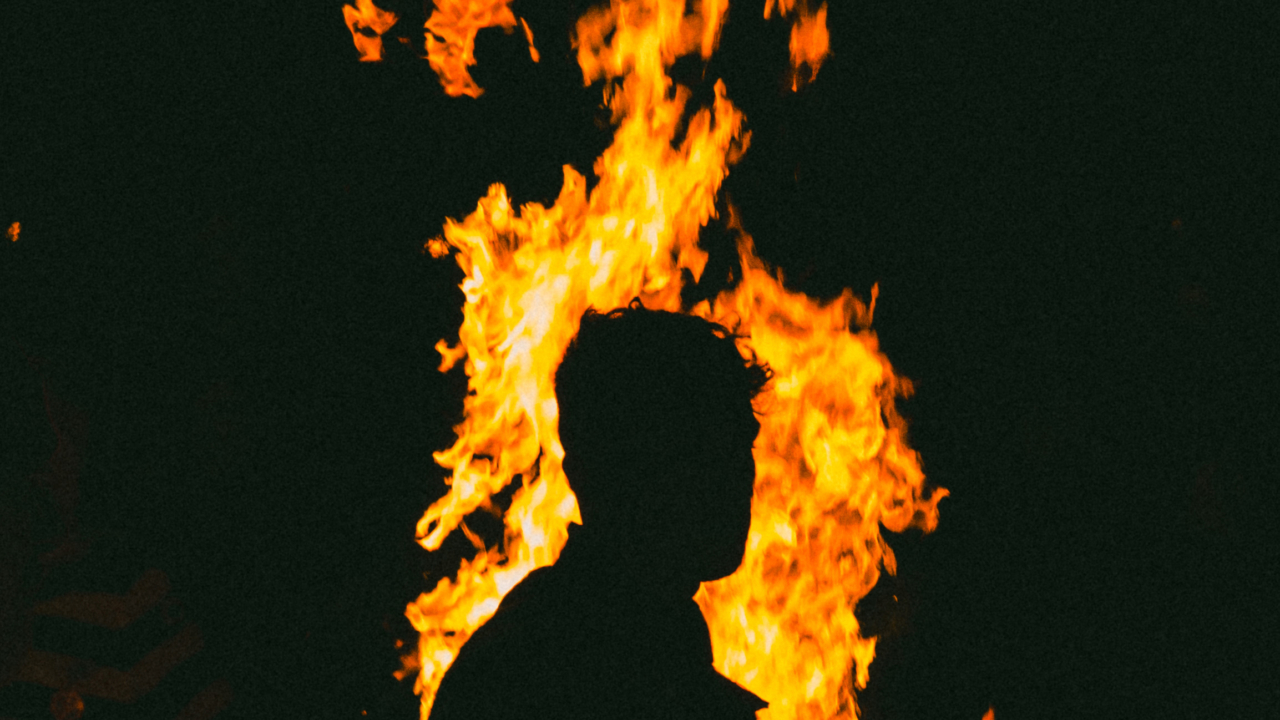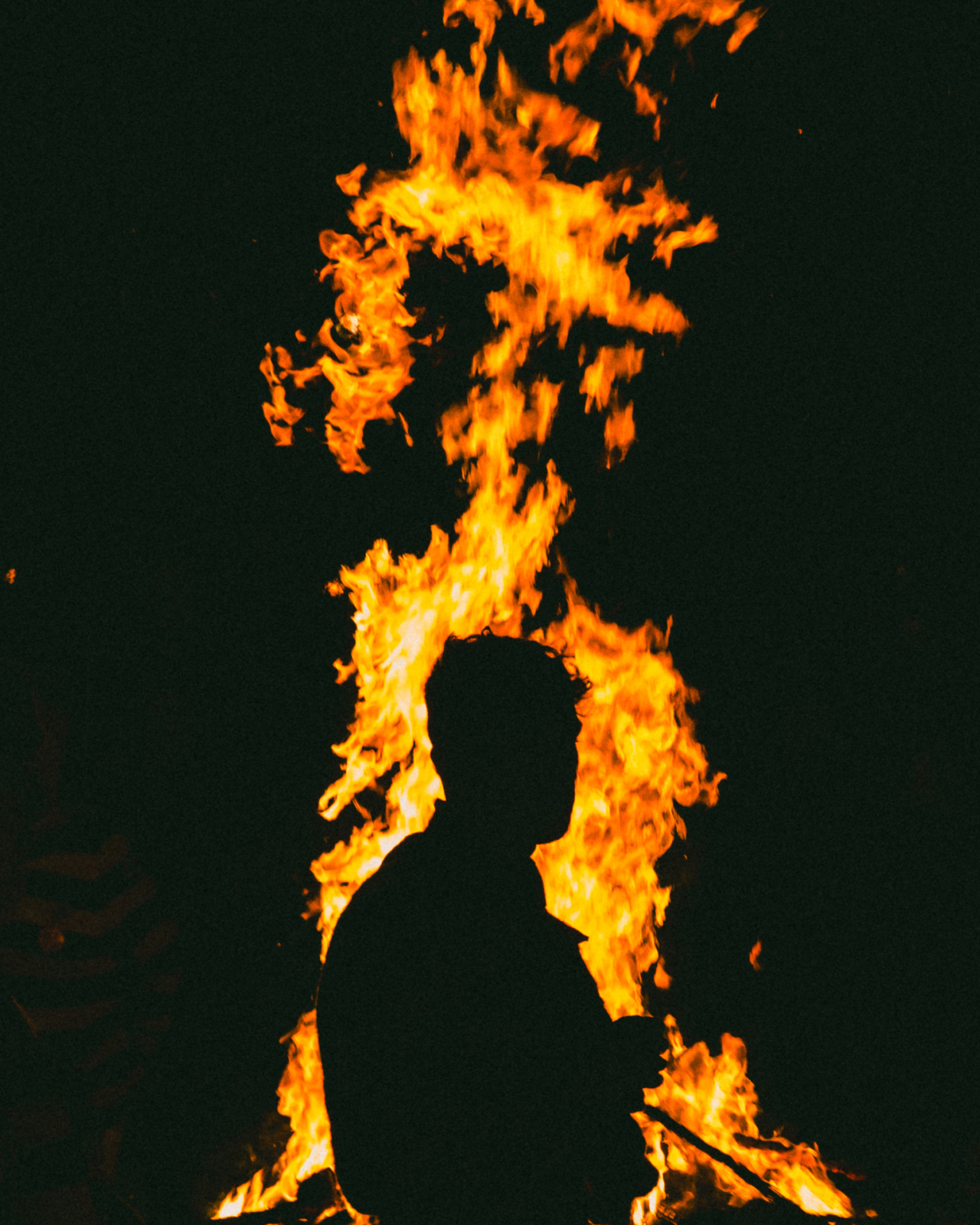

Photograph by Theo McInnes / Kintzing
From the flames over which early humans first cooked their hunts to the insatiable furnaces that drove the Industrial Revolution, fire has proved essential to human civilizations. Perhaps that’s why, from Prometheus to the Possum, cultures of all kinds pass down stories of how humans first tamed fire. In recent years, however, climate change has worsened forest fires, and what humanity once harnessed has regained its wildness.
For those who escape such a blaze, living with trauma is only natural—unavoidable. Many want to ensure they never experience anything like it again. Yet, their fears prevent some from considering one of the best methods available for preventing terrible fires in the future: good fires in the present.
Kyle Mason understands that fear well. In November 2018, just months into his first term at Butte College, Mason and his family were forced to flee their home in Magalia, California to escape the Camp Fire—the deadliest in state history. Smoke triggered anxiety, sometimes even a panic attack, in Mason for years afterward. But his relationship to fire and smoke began to change in 2023 after taking a course from environmental geographer Don Hankins at California State University, Chico, where he had transferred.
Hankins took Mason and other students on a field trip to nearby Big Chico Creek Ecological Reserve to experience prescribed fire. Hankins has extensive experience stewarding fire, working alongside agencies like the California Department of Forestry and Fire Protection, often simply called CAL FIRE, and as a Miwkoʔ (Plains Miwok) cultural practitioner. His field trips create an environment that puts students in intimate proximity to controlled fire. “It can be therapeutic,” Hankins said.
“It was a very healing experience,” Mason said. “When you’re able to light fire, it’s like putting the power back into your hands, especially when you’re a person that’s been so heavily affected by it.” That feeling of control, combined with the ecological benefits of prescribed fire and his cultural connection to it as an Acjachemen, inspired Mason to attend as many burns as he could. Over the past two years, he’s had a hand in more than a dozen.
Hankins has heard many students and community members describe a similar empowerment and healing. Though nobody has formally studied this phenomenon, it hasn’t stopped other practitioners from leveraging it. In Butte County, the site of the Camp Fire, a new program aims to expose people to good fire in a way that recognizes deep-seated traumas while creating an environment to repair that psychological harm.
Blake Ellis, who manages the ecotherapy program at Chico State, first dreamed up pyrotherapy several years ago. While leading forest therapy walks for Camp Fire survivors, she heard time and again how people’s trauma was connected to their sensory environment; the whistling winds in the trees and the smell of smoke were triggering for many. Throughout the walks Ellis guides, participants gather in circles to share what they’re feeling and noticing. One survivor told Ellis and the group, “Today is the first time since the [Camp] Fire that I’ve been able to feel the wind on my skin and have it be pleasant and pleasurable instead of triggering.”
That moment, and others like it, caused Ellis to think about how the tools of forest therapy could be tweaked to heal relationships with fire—a major hurdle in getting fire victims comfortable with prescribed burns in fire-prone areas like Butte County.
“The only way to really get the pace and scale that we need is to have a lot more people on board with the prescribed fire movement,” Ellis said. “But how can we do that in a way that is trauma-informed, in a way that recognizes that people are going to be afraid, in a way that doesn’t just get them to use prescribed fire, but actually starts to heal their relationship with fire?”
“When you’re able to light fire, it’s like putting the power back into your hands, especially when you’re a person that’s been so heavily affected by it.”
Ellis’ answer was a new offering called community pyrotherapy. She teamed up with David Mitchell, the coordinator for the Butte County Prescribed Burn Association, and He-Lo Ramirez, the manager of the cultural stewardship program at the ecological reserve and treasurer of the Mechoopda Tribal Council, the Native people whose ancestral lands were centered on a village just south of where Chico sits today. Together, they created a program that educates people about the ecology of fire, the Indigenous uses of fire, and the innate relationship between humans and fire, before engaging participants in a form of nature therapy involving interactions with a live fire.
Their first event in January at Noble Park in Paradise, California, saw around two dozen participants, many of whom had experienced wildfires. Some even lost their homes to the Camp Fire. Ellis, a trained social worker and mental health service provider, was prepared for the worst. But her crisis plan was never needed.
“During the last part of our day, when we did the nature therapy session,” Ellis said, “I had 20 people feel so relaxed next to a fire that they laid down and closed their eyes.” She knew then that they were onto something that could be profoundly healing for fire-stricken communities.
Mason attended a pyrotherapy event in the spring. Although his visceral reactions to flame and smoke had long diminished since beginning prescribed fire work, he still found himself getting calmer as Ellis encouraged participants to experience the sensations that accompanied the fire: the crackle of coals, the smell of smoke, the whistle of wind. “But I think the most impactful thing was seeing how other people reacted to that,” Mason said.
Some—including Mason—feel skeptical at first about ecotherapy and pyrotherapy—sounding, as they do, quite New Age-y. But Ellis’ guidance and energy help people shed their doubts. Central to nature therapy is the idea that everything is an invitation: No one should feel pressured to participate. And Ellis herself radiates an authenticity that gets people to lean in, Mason said: “You can just tell she believes in what she’s doing.”
Expanding the opportunities for people to get exposed to good fire is increasingly critical, given that fire burned five times as much area across California in the 2010s as it did in the 1970s.
Lenya Quinn-Davidson, director of the Fire Network through the University of California Division of Agricultural and Natural Resources, co-founded the state’s first prescribed burn association in Humboldt County in 2017. PBAs are grassroots organizations that encourage the use of good fire by providing learning opportunities to the public and coordinating prescribed burns on private land. She’s often found that the approach’s biggest hindrances are a lack of training and understanding around permitting rather than awareness. Most people she meets are supportive of the work and eager to get involved. “We’re at a point in California where people are pretty desperate for solutions around fire,” Quinn-Davidson said. “We don’t get a ton of pushback.”
But she recognizes that people from regions experiencing unending smoke or encroaching wildfires may resist seeing fires intentionally set. “I think that’s probably why Butte is such a good example, and why the work that Blake [Ellis] is doing is so important,” she said. When people are dealing with the trauma and stress of having survived a wildfire, it “takes a whole level of care and thought about how to bring prescribed fire back into a community like that.”
That approach includes making sure people are notified about upcoming burns so that, should they see the smoke, they know that it’s deliberate. But notifications aren’t always sufficient to quell anxieties.
Hankins has seen how resilient the trauma response can be. On November 8, 2024—the sixth anniversary of the Camp Fire—Hankins took his students out to a burn being run by Mitchell and the Butte County PBA. Hankins and Mitchell took great care to avoid triggering people and announced the burn ahead of time on social media; still, some community members felt that choosing to burn on the anniversary of the fire was insensitive to the living and the dead. But as Hankins sees it, “We have to stop thinking about commemorating these events, and we need to start thinking about how we can heal the land and heal each other.”
Mason, one of that day’s fire keepers, found the choice of date sentimental. “Here’s this thing that was so traumatic, but here I am, on that day, on the anniversary, using fire,” he said. “That one felt particularly special.” Still, he has patience and understanding for those who felt like it was inappropriate. He said he’s tried his best to help them understand that prescribed fire is necessary to prevent future disasters like the Camp Fire. And, to some degree, he feels that the best way for people to understand that is for them to tend fire themselves.
“I understand not everyone’s at the point,” Mason said, “but I would love to see people come and go to a prescribed burn association burn and just see what it’s like, and change that relationship with fire.”
Healing the West’s Relationship With Fire through Pyrotherapy